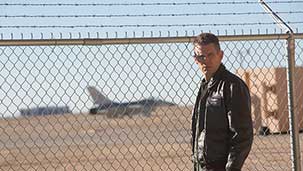Like so much of Good Kill your work is thoughtful and competently executed. The main title sequence, which features GPS co-ordinates running beside each credit, as if tracking the person in real time, is an interesting conceit. Unfortunately the film never quite rises to the promise of that beginning.
Ethan Hawke is largely convincing as a US Air Force veteran adjusting to his new reality of remotely piloting drones from a station in the Nevada desert. The supporting cast, most notably January Jones as Hawke’s wife and Zoe Kravitz as Hawke’s rookie co-pilot, also perform admirably, given what they have to work with.
The film begins strongly. We witness Hawke’s gradual descent into alcoholism and emotional isolation as he struggles with the dissonance between killing at a distance of seven thousand miles and his previous experience of war. Much of his character’s struggles stem from the difficulty of managing the transition from the messy, adrenaline driven reality of war into the antiseptic labor of piloting a joystick in an air conditioned box.
Where the film begins to falter is with the arrival of the CIA (represented by the officious and disembodied voice of Peter Coyote over speakerphone) and the split between the morally conflicted protagonists and those in the unit that are happy to kill anyone with a beard and turban. Hawke’s seemingly inevitable alienation from his wife and children also reinforces the feeling that the plot is driving the characters actions, rather than the other way around. These moments all feel like something being checked off a list rather than events emerging organically from the story.
There are some positive moments though. Not the least of which is a recurring visual device where we see the suburbs of Nevada as if through the eyes of a drone. This mirrors many of the remote combat sequences in Afghanistan—with the important difference being Hellfire missiles aren’t vaporizing the houses in Nevada.
Visually the film utilizes the stark, binary nature of the Nevada desert to good effect, creating a counterpoint to the empty truck containers that house the pilot’s combat stations. Each time Hawke emerges from the dark interior into the relentless glare of the desert sun both he and the audience are reminded of the surreal nature of this kind of modern warfare.
In the end though Good Kill is too didactic to completely succeed as a drama. This is most apparent in Coyote’s performance as the CIA “voice” which is essentially a bunch of empty moustache twirling rather than the kind of moral ambivalence and careerism you can find in films like Zero Dark Thirty. It is this lack of character depth and the transparency of its political leanings that prevents Good Kill from being more than an anti-drone polemic.
There is a fascinating and complicated film to be made about exactly what it means to utilize drones as a means of waging war. Sadly, as I watched your lovely end credits roll, Kate, I knew I had yet to see that film.
Sincerely,

Tim







